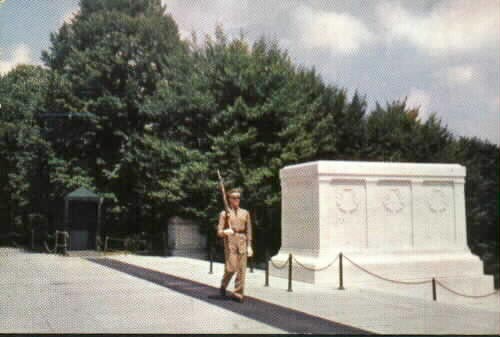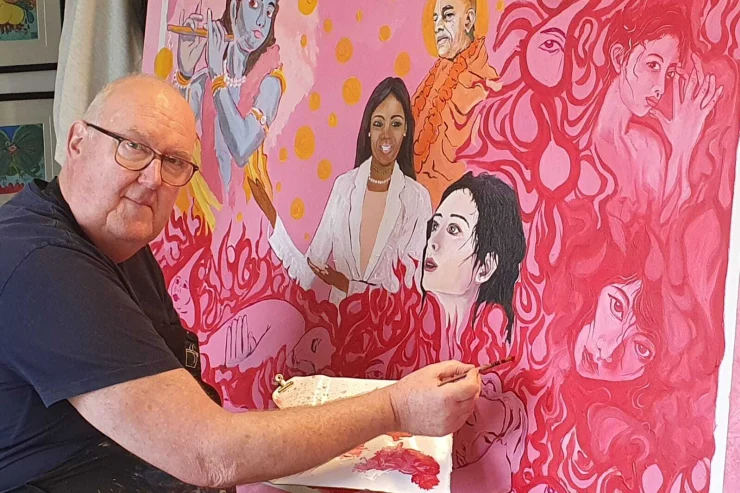The Hare Krishna Movement’s Unknown Soldier
By Sesa Dasa | May 02, 2009

Although I was born the eldest son to a career US Army officer who served during two wars, and attended a well known military academy with over two centuries of tradition, I never really understood all the pomp and circumstance evoked by the Tomb of the Unknown Soldier. That is”¦until now.
The theory is explained on Wikipedia: “The anonymity of the entombed soldier is key to the symbolism of the monument: since his or her identity is unknown, it could theoretically be the tomb of anyone who fell in service of the nation in question, and therefore serves as a monument to all of their sacrifices.”
Okay, but who’s into symbolism? Theories don’t explain the emotions stirred, even in world leaders, when people visit one of the 44 such monuments in 42 countries around the world. It may sound somewhat contradictory, but my conclusion is that the real key is to know an unknown soldier. Then you can understand the emotions. I understand now because I got to know an unknown soldier of the Krishna Consciousness Movement this week.
On April 16, 2009 Shyama Priya Devi Dasi, a disciple of His Divine Grace A.C. Bhaktivedanta Swami Prabhupada passed away at the age of 60. Didn’t know her, don’t recognize the name, that’s not surprising. I really didn’t know her either, even though we lived in the same devotee community for years. But know for certain that just as the unidentified soldiers lying in those tombs are sometimes identified on stone inscriptions as “known but to God,” Shyama Priya Devi Dasi was not only known to Lord Krishna but to a host of others, others that we collectively would rather leave unknown.
Shyama Priya Devi Dasi put the movement in the Hare Krishna Movement. She moved hearts and changed lives, most notably the hardened hearts of those gone errant ways and now dwelling in the physical prisons of this material world. For the last twenty years of her life Mama Shyama mothered for lost souls through the ISKCON Prison Ministry.
“She had 500 sons,” exclaimed Chandrasekhar Dasa, Mama Shyama’s longtime partner in the ISKCON Prison Ministry, as he began to describe how she worked tirelessly to get Srila Prabhupada’s books, tulasi beads, japa beads, kartalas, and even deities into prisons throughout the United States. She would regularly dedicate herself to correspondence with hundreds of prisoners simultaneously. Hand written correspondence, not e-mail. Her natural born son Nimai told of the Mother’s Day card she received last year signed by 21 prisoners from OSP, Oregon State Penitentiary. She was successful in this service because she was completely non-judgmental.
Bhakti Lata Dasi knew Shyama Priya, “She taught me important life lessons while she was alive, as she was dying, and even after she died. Although pancreatic cancer is most painful, Shyama Priya never complained; it was easy to forget she was sick at all.
One day I was at her house looking for 2 books she had kept for a prisoner. I could only find one of them. Shyama Priya then got up and started looking herself. I urged her to go back to bed, but only when her physical strength gave way did she finally lie back down. That was 10 days before she passed away. She taught me how to serve till the end.”
Again, the theory is that an unknown soldier cannot be too special as he or she must be representative of all. But, the fact is that such unknown soldiers are special and this exactly why they are immortalized. If we could know an unknown soldier he or she would probably be a lot like Ira Hayes, the Native American Marine who was amongst the warriors raising the US flag on Iwo Jima Island, immortalized in the US Marine Corps War Memorial monument. There are both parallels and differences between the lives of Ira Hayes and Shyama Priya.
Of Hayes a Wikipedia articles describes, “In 1954, after a ceremony where he was lauded by President Eisenhower as a hero, a reporter rushed up to him and asked him, “How do you like the pomp and circumstance?” Hayes hung his head and said, “I don’t.”
Similarly, Shyama Priya was comfortable with the fact that she was more likely to have cooked or served the Maha Prasadam given to a devotee as a reward for service than to be the recipient of such a reward.
Part of the mystic of the unknown soldier is this type of contradiction in their lives. On the one hand their actions are outstanding, and on the other hand they are disarmingly modest when fame is thrust upon them. Indeed, their lives are often marked by tribulation as a result of fame.
In his work, The Outsider, author William Bradford Huie describes that after the war Ira Hayes was arrested numerous times and finally died a neglected drunken death back on the “Indian Reservation.”
Shyama Priya also had to face tribulations in her life including, being a single mom and enduring a period of homelessness while raising her children. But as death approached her Shyama Priya manifested the difference in her life. Something Ira Hayes didn’t have, but something that Shyama Priya both had and gave to hundreds like him. That difference was Krishna Consciousness.
This is the second lesson Bhakti Lata learned from Shyama Priya, “In the last week, Shyama Priya, by then very weak, would greet her visitors by taking their hands for a long time, smiling at them with much love. She taught me that when you die, the only thing you have is your love for others and others’ love for you.”
In one sense the definition of a hero is one who goes far above and beyond the call of duty. Indeed, some of the extremes that result in heroism may be questionable. Was Shyama Priya tempted by such extremes in executing her service? Nimai tells of how she once truly hesitated when, with little money on hand, she had to choose between food for the family and books for the prisoners. Bhakti Lata’s third lesson gives us some insight into how Shyama Priya, through faith and dedication, may have been calculating the risks, “Helping with the fundraiser to assist Shyama Priya’s family after her departure, I witnessed with awe donations pouring from all over the States, in a spontaneous demonstration of the devotees’ love and appreciation for this saintly devotee. Even after her death, she taught me that when you devote your life to Lord Chaitanya’s service, Lord Chaitanya will always take care of you.”
One final question, a question that has never been asked to an unknown soldier, yet a question which clinches the designation, was mused by Shyama Priya. Bhakti Lata tells of Shyama Priya’s self-reflection, “Would she have done anything differently if she had known she would die so soon? That is exactly the question she was asking herself one month before she left. After reflection, Shyama Priya concluded, ‘I would continue my service; what else would I do?’”
Syamapriya Devi Dasi is the Hare Krishna Movement’s Unknown Soldier. At present she may be known, but over the course of time, as all of our names and personal characteristics are lost in oblivion, may this designation, being based upon her factual sacrifices, remain to serve as an ideal example and emotional inspiration for all. In the words of Candramauli Swami, “Congratulations for a life well spent.”















